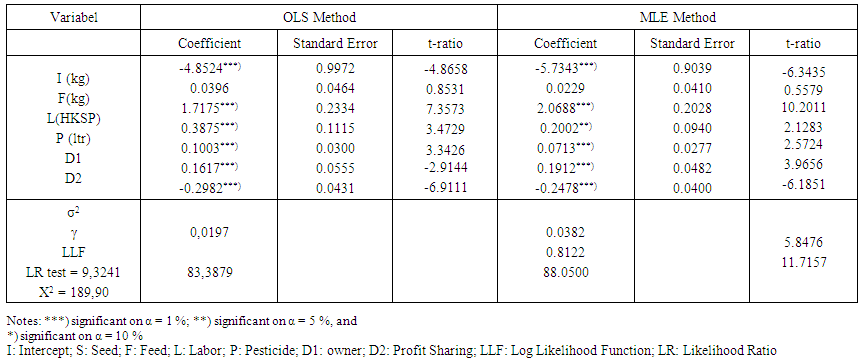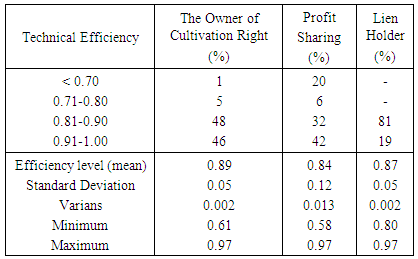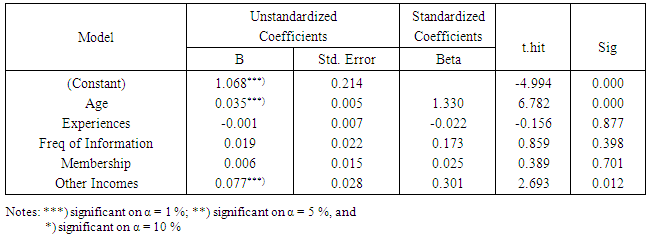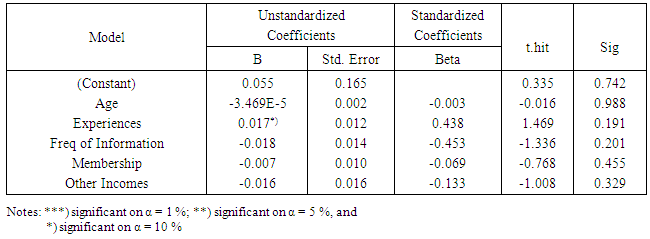-
Paper Information
- Previous Paper
- Paper Submission
-
Journal Information
- About This Journal
- Editorial Board
- Current Issue
- Archive
- Author Guidelines
- Contact Us
International Journal of Applied Sociology
p-ISSN: 2169-9704 e-ISSN: 2169-9739
2016; 6(1): 15-18
doi:10.5923/j.ijas.20160601.03

Measuring Technical Efficiency of Upland Paddy Farming in the Land of Ulayat Rights, Mausambi, Ende, East Nusa Tenggara (NTT), Indonesia
Willybrordus Lanamana1, 2, M. Muslich Mustadjab3, Nuhfil Hanani3, Kliwon Hidayat3
1Doctoral Student of Agricultural Economics, Agriculture Faculty, Brawijaya University, Malang, Indonesia
2Agriculture Faculty, Flores University, Ende, Indonesia
3Social Economic Agriculture Department, Agriculture Faculty, Brawijaya University, Malang, Indonesia
Correspondence to: Willybrordus Lanamana, Doctoral Student of Agricultural Economics, Agriculture Faculty, Brawijaya University, Malang, Indonesia.
| Email: |  |
Copyright © 2016 Scientific & Academic Publishing. All Rights Reserved.
This work is licensed under the Creative Commons Attribution International License (CC BY).
http://creativecommons.org/licenses/by/4.0/

Most agricultural lands in Ende, East Nusa Tenggara (NTT) is property of ulayat rights. This condition will determine the farming diversity, productivity and income level. The aim of this study is to analyse the level of technical efficiency of upland paddy farming in the land of ulayat rights. Sampling method used cluster sampling and data analysis was estimated using stochastic frontier Cobb-Douglass formula. The results showed that fertilizer and pesticide variable had positive and significant effect on production of uplad paddy farming (99%). While the variable of labor had positive and significant effect (95%). Seed variable showed positive effect on potential production, but not significant. The average level of technical efficiency of upland paddy farming on the land tenure status of the owner of cultivation right is higher than the land tenure status of profit sharing and lien holder. Factors that influence the technical inefficiency of upland paddy farming include: age, farming experience, the frequency of obataining the information, membership in farmer groups, other sources of income.
Keywords: Ende, Upland paddy, Ulayat rights, Technical efficiency
Cite this paper: Willybrordus Lanamana, M. Muslich Mustadjab, Nuhfil Hanani, Kliwon Hidayat, Measuring Technical Efficiency of Upland Paddy Farming in the Land of Ulayat Rights, Mausambi, Ende, East Nusa Tenggara (NTT), Indonesia, International Journal of Applied Sociology, Vol. 6 No. 1, 2016, pp. 15-18. doi: 10.5923/j.ijas.20160601.03.
Article Outline
1. Introduction
- Dry land in Ende regency is reached 86% from total land that is used for agriculture. This dry land has potential as agriculture land, but it is not fully utilized until now. Upland paddy is an important commodity in Ende Regency, but it is not followed by an increase in the paddy productivity. The average productivity per hectare of upland paddy in the Ende is lower than the upland paddy production from West Nusa Tenggara (NTB) province. The average productivity per hectare of upland paddy in Ende is only 2150 kg in 2013 and 2250 kg in 2014; but in NTB, it can reach 4065 kg and 3422 kg in 2014.Most agricultural lands in Ende is property of ulayat rights that is belong to Mosalaki (head of society). Recently, there is a serious problem beause of changing cultural value of ulayat right. Property of ulayat right was changed to a new land tanure and used new bussiness system that are profit sharing and farmland lien. Different status of land tenure will determine the farming diversity, productivity and income level [1-5]. Previous study explains that profit sharing system lead to inefficiency of production [6]. Meanwhile traditional profit sharing has no effect to inefficiency of production if the land owner have authority to suggest the labor number [7].This study will measure the technical efficiency of upland paddy farming from three land tenure status in the land of ulayat rights by using frontier production formula. Frontier production formula is used to determine the highest production potential which can be achieved by farmer from any input combinations [8].
2. Materials and Methods
- This research was conducted at Mausambi Village-Maurole Subdistrict, Ende Regency, East Nusa Tenggara (NTT) Province. Population of farmers at Mausambi village was 214 farmers. The number of share croppers, lien holders, and the owner of cultivation right were 36 people, 32 people and 146 people, respectively. Cluster sampling was used in this research. The sample size was calculated based on Parel formula [9]. The sample size per land tenure status was 92 farmers for the owner of cultivation right, 34 farmers for profit sharing and 21 farmers for lien holders.Production formula of stochastic frontier Cobb-Douglass was applied in this research, the formula was written as follows:Ln Y + β0 + β1 InX1 + β2 InX2 + β3 InX3 + β4 InX4 + EjDj + (Vj – uj)Description:Y = Production (kg); X1 = Size of land area (Ha); X2 = Seeds (kg); X3 = Fertilizers (kg); X4 = Labor, both household labor and non-household labor (Equal Employment Day); Ej = Dummy variable coefficients; Dj = dummy variable of land tenure status; D1=1 for the status of the owner, 0 for others land tenure status; D2=1 for profit sharing, 0 for others status, βi = regression coefficients ( i = 0,1,2,... n); vj = a symmetric, normally distributed random error or random error models and uj = one-side error term (uj ≤ 0) or random variables.To analyse the factors that influenced the technical inefficiency was used a linear regression model which was estimated simultaneously with frontier production formula. Technical inefficiency linear regression model was formulated as follows:Ui = δ0 + δ1Z1 + δ2Z2 +δ3Z3 + p1D1 + p2D2 + ƐiDescription:Ui = Technical inefficiency was obtained from analysis of stochastic frontier production formula; Z1 = The age of farmers (years); Z2 = The farmer experience (years); Z3 = Frequency of obtaining information about farming. This variable was accumulated information from counselors, other farmers, printed and electronic media, and sales; D1 = Dummy variables for membership in farmer groups (1 = if yes, 0 = if not), and D2 = Dummy variables for others source of income (1 = if yes, 0 = if not). Estimation parameters of the production and inefficiency formula were conducted simultaneously using FRONTIER 4.1c program [10].
3. Results and Discussion
3.1. Potential Production of Upland Paddy Farming
- The results of Stochastic Frontier production formula showed that regression coefficient on the land variable is negative. It means that the increase of land area can not increase harvesting production. This result is not supported by any theoritical data. So it can be solved by making ratio between all variables and land variable. Stochastic frontier estimation results by using MLE approach is better than the OLS approach. It is caused by the MLE approach shows that the sigma-squared value and the value of the log likelihood is higher than OLS approach. Estimation of the production by using MLE method showed that the variable of fertilizer and pesticides has positive and significant effect (α = 1%). The variable of labor also has positive and significant effect (α = 5%). If the variable of fertilizer, pesticides and labor is added 10%, so the production of upland paddy per hectare will increase 20.69%, 0.71% and 2.00%, respectively. Seed variable showed positive result, but it was not significant. It means that increase the number of seeds will not increase the production of upland paddy. This is caused by the plant spacing is already optimum (26 cm × 26 cm).Dummy variable showed a significant result. Dummy (D) parameter has positive value for the variable of D1 (owner). It means that the production on the land tenure status of the owner of cultivation right is higher than the others tenure status. While dummy (D) parameter coefficient has negative value for the variable of D2 (profit sharing). It means that the production function on the land tenure status of profit sharing was lower than others land tenure status.
3.2. Technical Efficiency Analysis
- Table 1 shows that the technical efficiency of each farmer is very different. It is indicated by the gamma coefficient value is 81.22%. It means that the variation of upland paddy production is contributed from technical efficiency (81.22%).
 | Table 1. Production estimation results based on the land tenure status of the owner of cultivation right, profit sharing and lien holder by using OLS and MLE method |
|
|
|
|
4. Conclusions
- It can be concluded that fertilizer, pesticide, labor and seed variables had positive effect on potential production of upland paddy farming with different significance. The average level of technical efficiency of upland paddy farming on the land tenure status of the owner of cultivation right is higher than the land tenure status of profit sharing and lien holder. Factors that influence the technical inefficiency of paddy field farming include: age, farming experience, the frequency of obataining the information, membership in farmer groups, other sources of income.
 Abstract
Abstract Reference
Reference Full-Text PDF
Full-Text PDF Full-text HTML
Full-text HTML


